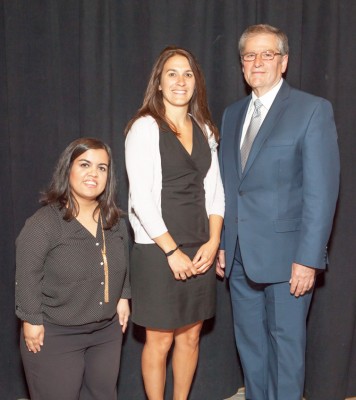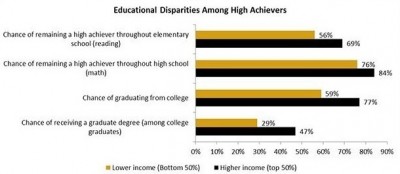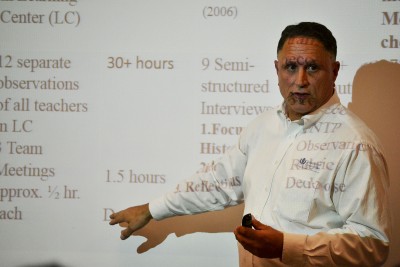 Below are news and notes from our alumni, faculty, staff, and students. We are proud of all the amazing accomplishments by our Neag family. If you have an accolade to share, we want to hear from you! Please send any news items (and story ideas) to neag-communications@uconn.edu.
Below are news and notes from our alumni, faculty, staff, and students. We are proud of all the amazing accomplishments by our Neag family. If you have an accolade to share, we want to hear from you! Please send any news items (and story ideas) to neag-communications@uconn.edu.
Sport Marketing undergraduate students competed in the national Washington Media Scholars Foundation Competition on Feb. 11, 2015.
Terra Briody, a track-and-field student-athlete and elementary education major, was recognized at UConn’s annual “3.0 Night” for her cumulative GPA.
Ty McNamee, second-year HESA student, has had programs accepted at two major conferences.
Jon Rizzo, Ph.D. candidate in adult learning, had an article published based on his dissertation, “Patients’ mental models and adherence to outpatient physical therapy home exercise programs” in Physiotherapy Theory and Practice, Early Online.
Current Neag master’s degree student Melissa Thom is the 2015 recipient of the Distinguished Teaching Award – K-12 from the National Council for Geographic Education.
Current Neag master’s degree student Christopher Todd, a social studies teacher at Windsor (Conn.) High School, served on a panel with U.S. Secretary of Education Arne Duncan at the 2015 Teaching & Learning Conference in Washington, D.C. Todd also currently serves at the Connecticut State Department of Education as a teacher leader-in-residence with the Talent Office.
Alumni
Marc Balanda ’99 and ’00, assistant principal at New Milford High School, takes over as principal at Brookfield High in Brookfield, Conn., this summer.
Josh Brandfon ’07 is chairing a major conference for the National Association of Campus Activities and was recently selected for the doctoral program at the University of Miami.
Rhema Fuller ’08 MA, ’12 Ph.D. took a faculty position at University of Memphis in Memphis, Tenn. Most recently he had been teaching at Alfred State University.
Erin Hagan ’09 Ph.D. is deputy director of a Robert Wood Johnson Foundation national program office in Princeton, N.J., for cultivating a culture of health.
Anne Birge James ’05 Ph.D. is a newly tenured professor of occupational therapy at University of Puget Sound in Tacoma, Wash.
Jordan Maleh ’07 BS, ’09 MA was appointed the director of digital and consumer marketing at Big 10 Network in Chicago, leaving University of Michigan.
Lauren Midgette ’12, ’13 and Paul Griswold ’10, ’11, English teachers at Bulkeley High School in Hartford, Conn., were selected to participate in the Stanford Hollyhock Fellowship program for high school teachers. They are among a select group of highly motivated, early-career teachers who will travel to Stanford University over two summers to gain professional development around urban teaching.
Dorothy Blozie Morrill ’77 was inducted into the South Windsor High School Athletic Hall of Fame. She was a teacher at Lyman Memorial High School from 1973 to 2009 and English department chair from 1999 to 2009. She was very active in student athletics, including being assistant girls’ and boys’ cross-country coach (1979-1987) and head boys’ and girls’ cross country coach (1987-1997). She also coached girl’s Class S State champion Teams for four consecutive years (1987-1990) and girls’ Champions of the Quinebaug Valley Conference for five consecutive years (1987-1991).
Two Executive Leadership Program graduates have moved into new superintendent positions: Jeff Newton ’13 was appointed superintendent in East Lyme, Conn. and Karen Baldwin ’05 was appointed superintendent in Ridgefield, Conn.
Matt Ouimette ’12 was appointed as an admissions counselor in the UConn Admissions Office.
Anita Guardo Satriano ’66 who taught kindergarten for nearly 30 years at the Annie E. Vinton Elementary School in Mansfield, Conn., received the Mary Rosa McDonough Award from the University of Saint Joseph for “outstanding service and distinction in education.” She is a longtime member of Delta Kappa Gamma Society International (DKG), a women’s organization dedicated to education. As chair of its Committee on A Curriculum of Hope for a Peaceful World, Satriano helped develop a curriculum for students in first grade through middle school.
Martin Semmel ’95, ’96, ’03, ’07 was appointed superintendent of Plymouth Public Schools in Plymouth, Conn. Most recently, he had served as principal at Southington High School.
Donna Shea ’11 (master’s degree in adult learning), director of the Connecticut Technology Transfer Center, was awarded the 2014 Women in Transportation, WTS Connecticut Woman of the Year Award for her “exceptional contributions to the transportation industry; [her] role in the implementation of several successful programs; and especially [her] leadership, both [her] efforts in leadership training for others and the example [she] sets every day as a capable professional.”
In memoriam:
Aaron D. Anderson ’87
Diane M. Barrante ’73
Nancy A. Booker ’55
John S. Borg ’73
Teresa D. Brastow ’73
Doris B. Demarest ’49
Joshua P. Eudy ’02
Doris Factor ’53
John P. Granniss ’78
Irving Harris ’50
Priscilla A. Howland ’57
Sara L. LaMont ’11
James Lorello ’58
George A. Mullin ’70
Louis E. Notorantonio ’63
Charles G. O’Brien ’63
Ruth C. Page ’81
Catherine A. Pritchard ’84
Evelyn L. Roper ’56
Ronald J. Schmitt ’61
Richard Silva ’71
Carol A. Taylor ’89
Maureen J. Timoney ’82
James Vendetti ’67
Irene J. Vlahakos ’74
Lloyd B. Wilhelm ’50
Faculty/Staff
Staff from Husky Sport – Danielle DeRosa and Patricia Bellamy – represented the Neag School on the two-way exchange program through UConn’s Global Training and Development Institute (GTDI). The focus of the partnership with the University of the Western Cape is sport-based youth development. DeRosa coordinated the trip through her role with GTDI, and Bellamy attended on behalf of Husky Sport and was paired with a sport-based youth development fellow who came to UConn this past fall.
Husky Sport is again participating in the “Ignite UConn student fundraising competition.” They look forward to defending their 1st place finish during last year’s competition. In addition, Husky Sport received funding from the USDA’s Supplemental Nutrition Assistance Education Program for $342,526 for 2015.
The New London Renzulli Academy hosted a presentation in March by Gabriel bol Deng and the HOPE for Ariang Foundation for the Academy students, along with invited students from the Science and Tech High School. Deng is a “Lost Boy” of the Sudan. Nicole Waicunas, SEM outreach coordinator with the Neag Center for Creativity, Gifted Education, and Talent Development, who first met Gabriel while she was a faculty member at E.O. Smith High School, coordinated the visit.
Sport Management hosted Doug Ritchart and Matt Moorman, PLB Sports Founders (famous for creating Flutie Flakes), as guest presenters in their undergraduate Sport Marketing class. The students are working on a marketing plan proposal for the company with their new product titled “Husky Heroes” cereal, with Coach Auriemma and Coach Ollie as the endorsers on the box.
CommPACT hosted a Friday Cafe networking meeting in March for community members to talk about an online system to gather information on links among parents and between families and teachers.
Congratulations – Research Excellence Awards
The Office of the Vice President for Research is very pleased to announce the recipients of the 2015 Research Excellence Program (REP) awards. The 2015 REP Neag awardees are:
- Jennifer Freeman, PI, Educational Psychology, Reducing High School Drop Out by Embedding College and Career Readiness into School-wide Positive Behavior Interventions and Supports $24,737.
- Devin Kearns, PI, Educational Psychology, As Children Get Older, Do Long Words Get Easier? Longitudinal Examination of Polysyllabic Word Reading in Elementary-Age Children $23,580
- Tamika La Salle, PI, Educational Psychology and George Sugai, Co-PI, Educational Psychology, Increasing School Climate and Student Outcomes through PBIS $43,498
- Rachelle Perusse, PI, Educational Psychology, Melissa A. Bray, Co-PI, Educational Psychology, Erik M. Hines, Co-PI, Educational Psychology, Xaé Alicia Reyes, Co-PI, Curriculum & Instruction, Eliana Rojas, Co-PI, Curriculum & Instruction, Michael Young, Co-PI, Educational Psychology Making STEM Accessible to All Students: Teaching K-12 Students about STEM Careers $25,000.
EDLR faculty and alumni: Jennifer Bruening; Jon Welty Peachey; Justin Evanovich; Rhema Fuller; Cassandra Coble Murty; Vernon Percy; Lauren Silverstein; and Michael Chung published a special issue on managing sport for social change manuscript in Sport Management Review entitled “Managing sport for social change: The effects of intentional design and structure in a sport-based service learning initiative.”
Jennie Bruening is an investigator on the Provost’s Academic Plan grants Tier II submission Collaboratory for Coordinated School and Child Health (CCSCH).
Laura Burton, with co-author and UConn alumnus Jon Welty Peachy ’09, published “Examining the mediating effect of organizational culture in intercollegiate athletics” in the Journal of Intercollegiate Sport. Burton is also now editor of the Journal of Intercollegiate Sport.
Noel Card was selected as the next editor of the Journal of Research of Adolescence, the scientific face of the Society for Research on Adolescence. The journal is second-highest impact factor among adolescent development journals (behind an adolescent health journal), and it is reasonably solid among all developmental psychology journals.
The UConn Office of the Vice President has awarded Milagros Castillo-Montoya a Scholarship Facilitation Fund grant for research for her study entitled, “Higher Education and Student Affairs Administrators’ Learning of Assessment, Evaluation and Research.” Blanca Rincon serves as a Co-PI on this project.
Led by Joseph Cooper, the Collective Uplift (CU) student-athlete holistic development group completed its first semester in existence this past fall and is entering its second semester this spring. Cooper also presented at the inaugural Black Student Athlete Conference at the University of Texas at Austin in January. The title of his presentation was “Excellence Beyond Athletics: Best Practices for Enhancing Black Male Student Athletes’ Educational Experiences and Outcomes.” Cooper’s presentation at this event was cited in Diverse Issues in Higher Education.
Morgaen Donaldson is serving on the American Educational Research Association (AERA) Division A Dissertation Award committee. She was also selected as a recipient of Division A’s 2015 Emerging Scholar Award from AERA.
Morgaen Donaldson and Casey Cobb received the Outstanding Policy Report Award for their report entitled, “An Evaluation of the Pilot Implementation of Connecticut’s System for Educator Evaluation and Development” from the AERA Division L Outstanding Policy Report Award Committee.
Morgaen Donaldson and Dorothea Anagnostopoulos co-presented with another colleague, “How do teachers respond to teacher evaluation? The role of emotions” at the Association for Education Finance and Policy Annual Conference in Washington, D.C. in February.
Shaun Dougherty presented “The Effect of Career and Technical Education on Human Capital Accumulation: Causal Evidence from Massachusetts” at the Society for Research on Educational Effectiveness Spring Conference, in Washington, D.C., in March. Dougherty co-presented “Middle School Math Acceleration, College Readiness and Gender: Regression Discontinuity Evidence from Wake County, North Carolina” for the Society for Research on Educational Effectiveness Spring Conference, Washington, D.C., March 2015. Dougherty also presented “The Effect of Career and Technical Education on Human Capital Accumulation: Causal Evidence from Massachusetts” at the Association for Education Finance and Policy Annual Conference in Washington, D.C., February 2015.
Shaun Dougherty and Jennie Weiner co-presented “Islands of Improvement?: The Impact of Being Just Labeled as Low-Performing Under No Child Left Behind Waivers” for the Society for Research on Educational Effectiveness Spring Conference in Washington, D.C., March 2015. They also co-presented “The Rhode to Turnaround?: The Impact of Being Just Labeled as Low-Performing Under No Child Left Behind Waivers” at the Association for Education Finance and Policy Annual Conference, in Washington, D.C., February 2015.
Preston Green published “The Legal Status of Charter Schools in State Statutory Law,” which was accepted by the University of Massachusetts Law Review. He also spoke on a roundtable at the Children’s Rights Litigation Committee of the ABA, along with moderating a panel during UConn Law School’s Diversity Week. In addition, he co-authored “Cyber charter schools and students with dis/abilities: Rebooting the IDEA to address equity, access, and compliance” in Equity & Excellence in Education.
Robin Grenier was re-elected to a second term on the Board of the Academy of Human Resource Development (AHRD). Grenier presented two papers at the 2015 AHRD Conference in St. Louis: “Autoethnography as a legitimate approach to HRD research: A methodological conversation at 30,000 feet” at the Academy of Human Resource Development (AHRD), in St. Louis, MO. She also co-presented “Exploring recent measures of employee expertise for HRD applications” at the Academy of Human Resource Development (AHRD), St. Louis, MO.
Joshua Hyman gave a presentation “Data vs Methods: Quasi-Experimental Evaluation of Alternative Sample Selection Corrections for Missing College Entrance Exam Score Data” at the Association for Education Finance and Policy Annual Conference in Washington, D.C. in February.
James Kaufman was a panelist of the 92nd St. Young Men’s and Women’s Hebrew Association on “Genius and Madness.” He also co-authored a new study from the Journal of Family Issues titled “Do You Pursue Your Heart or Your Art? Creativity, Personality, and Love.”
Devin Kearns published “How Elementary-Age Children Read Polysyllabic Polymorphemic Words in the Journal of Educational Psychology. He also co-authored “Orthographic, Phonological, and Morphological Skills and Children’s Word Reading in Arabic in Reading Research Quarterly, along with “Modeling Polymorphemic Word Recognition: Exploring Differences Among Children With Early-Emerging and Later-Emerging Reading Difficulty” in the Journal of Learning Disabilities.
Mark Kohan won AERA’s Division K Outstanding Dissertation Award.
Kim LeChasseur had two grants awarded under CEPA: $20,000 from the William Caspar Graustein Memorial Fund for “Re-examining data driven collective impact philanthropy from a community location”; and $37,000 from the Hartford Foundation for Public Giving for “Adult Literacy Indicators Project.” She also has written and presented a white paper to the William Caspar Graustein Memorial Fund titled “Collective impact and the discovery initiative: Extending and problematizing the collective impact model.”
Allison Lombardi co-authored “The Impact of Professional Development on the Quality of the Transition Components of IEPs” for the journal Career Development and Transition for Exceptional Individuals.
Joseph Madaus was named full-time interim director of the UConn Avery Point campus, beginning on July 1.
Alan Marcus shared the WWII Exhibit designed by the Class of 2014 social studies students (“Snow, Sand, & Strategy: The Impact of Weather and Geography on World War II”) at the Dodd Center during the beginning of the semester.
In recognition of the team’s clinical expertise, UConn was recently awarded a five-year contract to serve as one of 13 evidence-based practice centers supported by the federal Agency for Healthcare Research and Quality. Neag’s Chris Rhoads will serve as the chief statistician.
Lisa Sanetti co-authored with colleagues from other universities, along with Neag doctoral student Austin Johnson, “Is Performance Feedback for Educators an Evidence-Based Practice? A Systematic Review and Evaluation Based on Single Case Research” in the journal of Exceptional Children.
John Settlage co-authored “College Student Persistence in Scientific Disciplines: Cultural and Social Capital as Contributing Factors” in the International Journal of Science and Mathematics Education.
John Settlage and Suzanne Wilson have been chosen as Outstanding Reviewers for 2014 for the Educational Researcher.
Jennie Weiner, Morgaen Donaldson, and Shaun Dougherty co-presented “Studying Up: Regression Discontinuity Evidence of the Effects of Receiving Commended Status Under a Waiver from No Child Left Behind Waivers” at the Association for Education Finance and Policy Annual Conference in Washington, D.C., February 2015.
Sarah Woulfin, book review of Barnett, Shoho, and Bowers’ book School and District Leadership in an Era of Accountability was published in Teachers College Record. She also served on the District Research and Reform SIG’s Dissertation Award Committee.
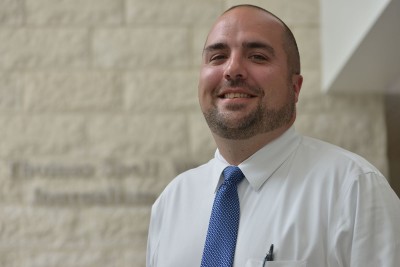
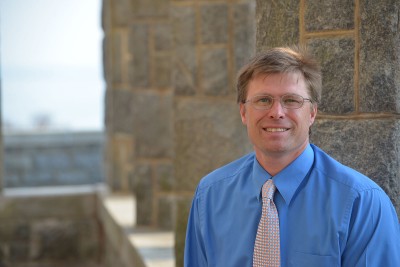

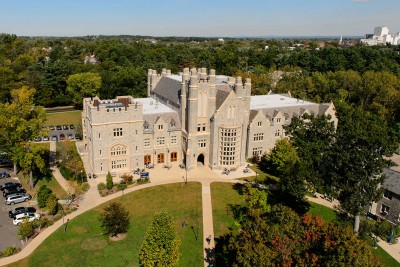
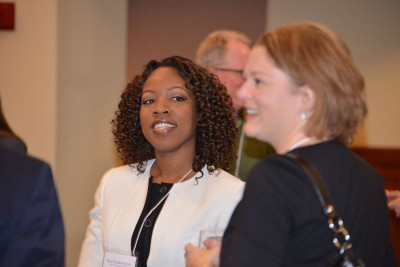

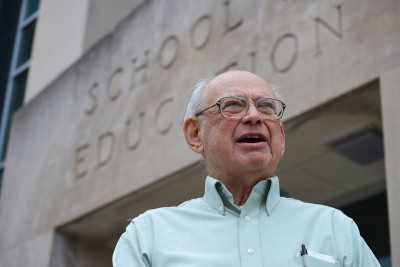
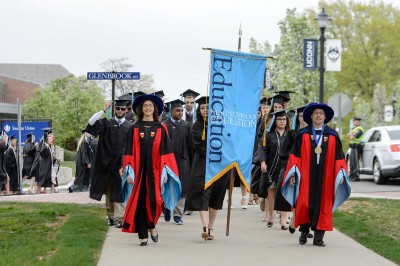
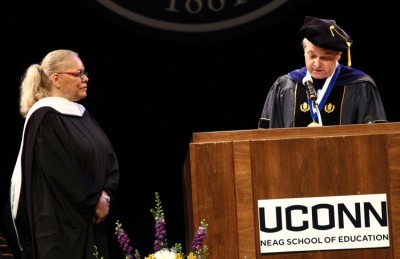 For her role as a distinctive leader, education advocate, and global citizen, the Neag School’s dean, Dr. Richard Schwab, awarded Sanford an honorary degree, the degree of Doctor of Humane Letters.
For her role as a distinctive leader, education advocate, and global citizen, the Neag School’s dean, Dr. Richard Schwab, awarded Sanford an honorary degree, the degree of Doctor of Humane Letters.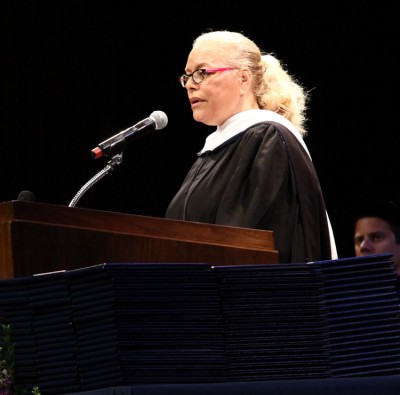 “As a teacher, you must believe in yourself, in the power of education to change lives, and in what your students can do,” she said.
“As a teacher, you must believe in yourself, in the power of education to change lives, and in what your students can do,” she said.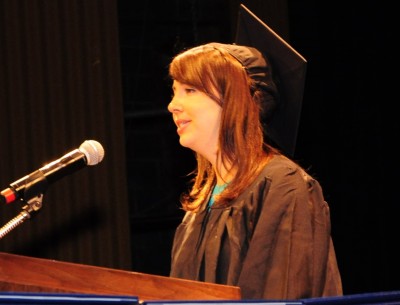 Carley Mooney, a graduating sport management major from Killingworth, Conn., served as the student speaker. This fall, she wlll return to the Neag School to take on a master’s degree in adult learning – while serving as a graduate assistant for the UConn women’s basketball team. As an undergraduate, she had served for four years as the student manager for the team.
Carley Mooney, a graduating sport management major from Killingworth, Conn., served as the student speaker. This fall, she wlll return to the Neag School to take on a master’s degree in adult learning – while serving as a graduate assistant for the UConn women’s basketball team. As an undergraduate, she had served for four years as the student manager for the team.